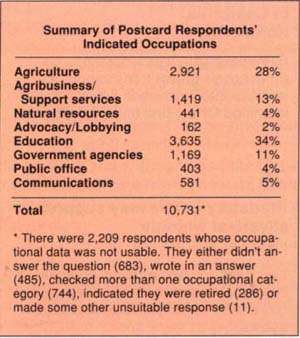All Issues
Readers spur change at
Publication Information
California Agriculture 48(2):4-4.
Published March 01, 1994
PDF | Citation | Permissions
Full text
California Agriculture readers are well educated, work in a variety of agriculturally related professions and want to learn more about environmental issues relevant to agriculture — including water use and quality, and pesticide alternatives. They seek thematic coverage of current agricultural concerns.
These were among findings from three California Agriculture surveys conducted to find out who reads the magazine, what their interests are and how we can serve them better.
In response to reader suggestions, we have scheduled more special issues and sections exploring subjects of high reader interest (such as the January-February 1994 issue “How Safe is the Food Supply?” and upcoming issues on “Farming in Transition” and “Biological Diversity and Agriculture”). We have also expanded our staff to include Pam Kan-Rice, who most recently worked as editor of California-Arizona Cotton, Nut Grower and Tree Fruit magazines.
With this issue, we introduce new sections written in concise, nontechnical terms by our staff. As space permits, we will feature Progress reports (describing UC research in progress which, because of its timely nature, has immediate value to our readers), Research updates (updating previously published research or providing information related to research in the current issue), and Science briefs (collected from the campuses and counties). When necessary, California Agriculture will expand its page length to accomodate original research submissions as well as the new sections.
Finally, in concert with recent readability research, we have increased the line spacing to make our text easier to read.
Thank you for your feedback. We intend to continue improving California Agriculture to better serve its readers. Your comments are welcome.
Survey response: the details
We sent a short postcard form on the dustcover of the July-August 1991 issue to 18,000 domestic readers. At the same time, a long survey form was sent to 1,059 randomly selected readers. With the January-February 1992 issue, a second long form was sent to a stratified random sample of about 1,600 readers; again it appeared as the dustcover.
Overall 70% of our 18,000 readers responded to the postcard-purge. The reader profile shown at left emerged from their responses.
The data reveal that California Agriculture has a relatively broad base of readers. Although the journal is peer-reviewed to meet high scientific standards, only one-third of its audience is in the education category. Two-thirds of readers report other occupational categories: 28% full-time farming, 13% agribusiness or support services and 11% government agency positions. Another 15% fall into the categories of communications, public office, natural resources (private sector) or advocacy and lobbying.
Long form data
The long form revealed that the average California Agriculture reader is well-educated. Of respondents, 88% are college graduates and 59% hold advanced degrees.
California Agriculture readers take a professional interest in the magazine; they read selected articles and save the magazine or pass it on to others. Of those responding, 56% read selected articles and 33% read most of the articles. Ninety-two percent report they use the information they've read in California Agriculture. When finished, 57% save the magazine and 30% pass it on.
Readers registered strong and repeated preferences for articles that related research to current agricultural concerns and controversies, and for overviews of research and technology. More than half of respondents wanted more coverage of environmental research as it relates to agriculture (58%), of pest and disease management (58%) and of soils, water and fertilization (56%). Almost as strong a preference emerged for more coverage of agricultural biotechnology (47%).
California Agriculture readers are loyal. Two-thirds said they would be willing to pay a subscription fee to cover publication and distribution costs.
—Editor





